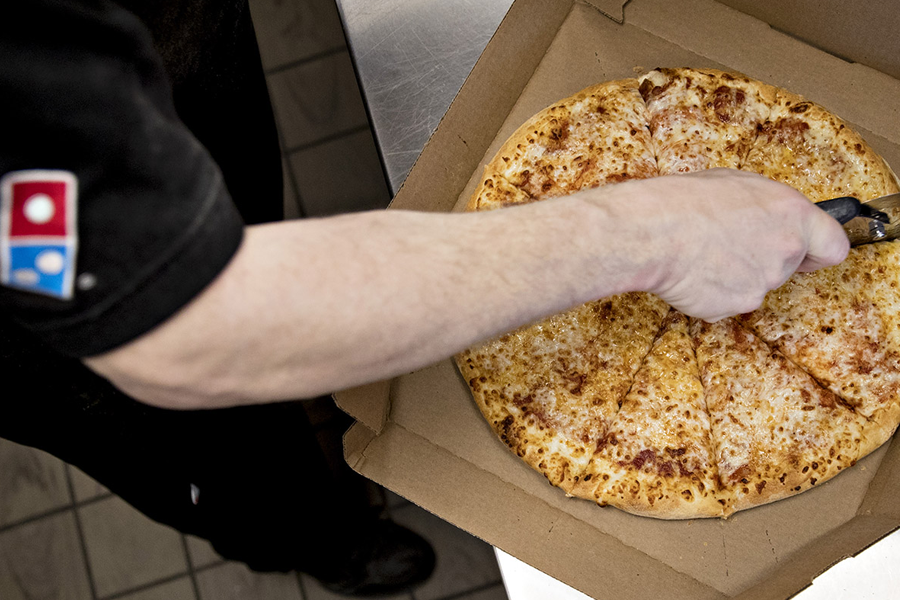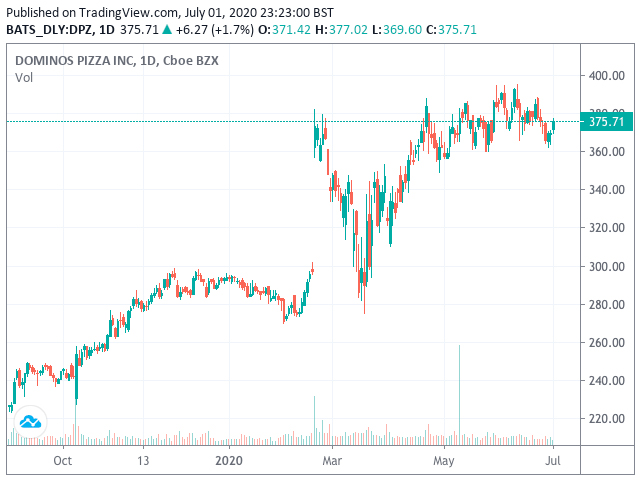
Thursday, July 02, 2020
Domino's Pizza’s share price has taken a bite out of Google
By Century Financial in 'Brainy Bull'


Domino's Pizza’s [DPZ] share price has climbed 26% so far this year to reach $369.44 on 30 June, while Google’s share price — now Alphabet [GOOGL] — is only up 3.6% in the same period after closing at a massive $1,418.05.
It is 16 years since Google and Domino's Pizza joined their respective stock exchanges in the US and, despite the plaudits received by the former and its FAANG peers, it's the pizza takeaway chain that has arguably relatively better share price performance of the two.
Since floating on the New York Stock Exchange at $14 a share, Domino's Pizza’s share price has risen 2,536.9% (through 29 June).
Domino's share price performance is one that you would come to expect from a technology giant. Google and now Alphabet’s share price, for example, has climbed 1,543% since its IPO offer price of $85 a share (through 29 June).


Putting tech at the heart of pizza
Despite techs dominance over the stock market, Domino's outperformance suggests that staple businesses can and do become top traded stocks. It’s not alone, one of its biggest competitors in the pizza delivery space, Papa John's International [PZZA], has risen 4,238% since its IPO, more than a decade before Domino’s Pizza in 1993.


In the early years, it was Google that was the more dominant of the two. The company profited from the growth of the internet, which drove up its advertising revenue.
But while everyone loves pizza, Domino's Pizza’s original focus was about getting affordable products to customers as quickly as possible. It developed a reputation for poor quality pizza, and as a result, the stock had an underperforming price-to-sales ratio from 2009 to 2010, according to the Motley Fool.
Over the years, the company has revamped its whole recipe and menu. Behind its success is not just a taste for its dough but also the technology that it relies on to attract sales and retain customers.
The company is very much an innovator in the takeaway restaurant space. It was the first major pizza chain to offer online and mobile ordering while allowing customers to check the progress of an order using its tracker, which debuted in 2008.
Its innovative approach is, arguably, why its share price has remained steady during the COVID-19 crisis. Sales are up amid the global lockdown restrictions. The company has even been on a hiring spree to help to cope with the demand.
Google, meanwhile, is likely to see its ad revenue fall as global advertising spend slows down as a result of the coronavirus pandemic. In Q1 2020, advertising accounted for 82% of total revenue.


Total revenue was $41.15bn, up 13% year-over-year, and ad revenue was up 10% year-over-year at $33.76bn. This, however, marked a sudden slowdown in growth, and forecasts point towards things getting slightly worse in the months ahead.
Both Domino's Pizza and Alphabet have seen their share prices recover since the market sell-off on 23 March. They have recovered 14.2% and 32.5%, respectively, as of 29 June.
Taking a bigger slice of the pie
Over the long term, Domino's Pizza is likely to remain a top-performing stock based on its increasing market share.
Since 2014, the company has grown its share of the pizza delivery market from 24% to 35%, according to Forbes. In 2019, its US sales were $7.04bn, making it the leading restaurant chain in the US — ahead of Pizza Hut [YUM] at $5.56bn and Papa John's at $2.64bn.
Domino's Pizza’s short-term outlook also looks positive. Although there have been worries that restaurants reopening post-lockdown could hit sales due to more people dining out, Matthew DiFrisco, an analyst at Guggenheim, isn't overly concerned.
"May's strong growth delivery, in our view, suggests there is more spending power from what we see as the more risk-averse households," DiFrisco wrote in a note to clients, reported by Barron's.


He reiterated a buy rating and raised the price target from $417 to $447 in the most bullish move of the 31 Wall Street analyst ratings available for the stock, according to MarketBeat. Among those polled 20 rate the stock a buy and 11 a hold.
As for Google’s stock, there are currently 44 ratings available, 42 of which are a buy and the other two a hold. The consensus price target is $1,535.60.
The consistent growth in Domino's Pizza’s share price, as well as the strong growth of Alphabet’s share price, is a good representation of how even not pure tech companies benefit from using technology to innovate.


Source: This content has been produced by Opto trading intelligence for Century Financial and was originally published on cmcmarkets.com/en-gb/opto
Disclaimer: Past performance is not a reliable indicator of future results.
The material (whether or not it states any opinions) is for general information purposes only and does not take into account your personal circumstances or objectives. Nothing in this material is (or should be considered to be) financial, investment or other advice on which reliance should be placed. No opinion given in the material constitutes a recommendation by Century Financial or the author that any particular investment, security, transaction or investment strategy is suitable for any specific person.
Century Financial does not endorse or offer opinion on the trading strategies used by the author. Their trading strategies do not guarantee any return and Century Financial shall not be held responsible for any loss that you may incur, either directly or indirectly, arising from any investment based on any information contained herein.















